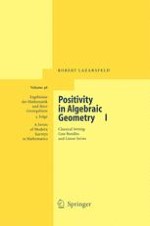2004 | OriginalPaper | Chapter
Introduction to Part One
Author : Prof. Robert Lazarsfeld
Published in: Positivity in Algebraic Geometry I
Publisher: Springer Berlin Heidelberg
Included in: Professional Book Archive
Activate our intelligent search to find suitable subject content or patents.
Select sections of text to find matching patents with Artificial Intelligence. powered by
Select sections of text to find additional relevant content using AI-assisted search. powered by
Linear series have long stood at the center of algebraic geometry. Systems of divisors were employed classically to study and define invariants of projective varieties, and it was recognized that varieties share many properties with their hyperplane sections. The classical picture was greatly clarified by the revolutionary new ideas that entered the field starting in the 1950s. To begin with, Serre’s great paper [530], along with the work of Kodaira (e.g. [353]), brought into focus the importance of amplitude for line bundles. By the mid 1960s a very beautiful theory was in place, showing that one could recognize positivity geometrically, cohomologically, or numerically. During the same years, Zariski and others began to investigate the more complicated behavior of linear series defined by line bundles that may not be ample. This led to particularly profound insights in the case of surfaces [623]. In yet another direction, the classical theorems of Lefschetz comparing the topology of a variety with that of a hyperplane section were understood from new points of view, and developed in surprising ways in [258] and [30].
